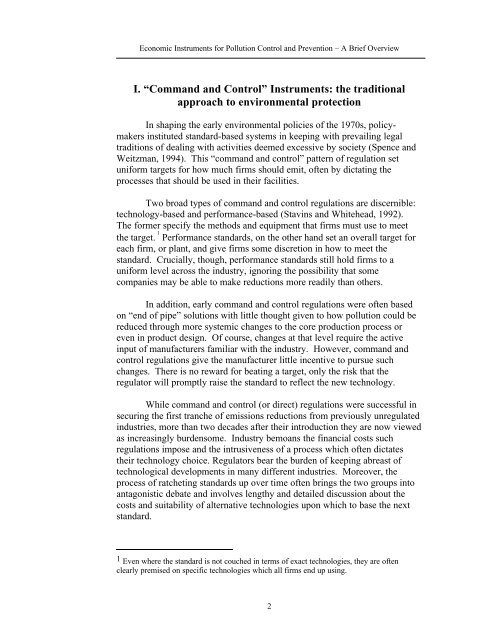Economic Instruments for Pollution Control and Prevention - World ...
Economic Instruments for Pollution Control and Prevention - World ...
Economic Instruments for Pollution Control and Prevention - World ...
You also want an ePaper? Increase the reach of your titles
YUMPU automatically turns print PDFs into web optimized ePapers that Google loves.
<strong>Economic</strong> <strong>Instruments</strong> <strong>for</strong> <strong>Pollution</strong> <strong>Control</strong> <strong>and</strong> <strong>Prevention</strong> – A Brief Overview<br />
I. “Comm<strong>and</strong> <strong>and</strong> <strong>Control</strong>” <strong>Instruments</strong>: the traditional<br />
approach to environmental protection<br />
In shaping the early environmental policies of the 1970s, policymakers<br />
instituted st<strong>and</strong>ard-based systems in keeping with prevailing legal<br />
traditions of dealing with activities deemed excessive by society (Spence <strong>and</strong><br />
Weitzman, 1994). This “comm<strong>and</strong> <strong>and</strong> control” pattern of regulation set<br />
uni<strong>for</strong>m targets <strong>for</strong> how much firms should emit, often by dictating the<br />
processes that should be used in their facilities.<br />
Two broad types of comm<strong>and</strong> <strong>and</strong> control regulations are discernible:<br />
technology-based <strong>and</strong> per<strong>for</strong>mance-based (Stavins <strong>and</strong> Whitehead, 1992).<br />
The <strong>for</strong>mer specify the methods <strong>and</strong> equipment that firms must use to meet<br />
the target. 1 Per<strong>for</strong>mance st<strong>and</strong>ards, on the other h<strong>and</strong> set an overall target <strong>for</strong><br />
each firm, or plant, <strong>and</strong> give firms some discretion in how to meet the<br />
st<strong>and</strong>ard. Crucially, though, per<strong>for</strong>mance st<strong>and</strong>ards still hold firms to a<br />
uni<strong>for</strong>m level across the industry, ignoring the possibility that some<br />
companies may be able to make reductions more readily than others.<br />
In addition, early comm<strong>and</strong> <strong>and</strong> control regulations were often based<br />
on “end of pipe” solutions with little thought given to how pollution could be<br />
reduced through more systemic changes to the core production process or<br />
even in product design. Of course, changes at that level require the active<br />
input of manufacturers familiar with the industry. However, comm<strong>and</strong> <strong>and</strong><br />
control regulations give the manufacturer little incentive to pursue such<br />
changes. There is no reward <strong>for</strong> beating a target, only the risk that the<br />
regulator will promptly raise the st<strong>and</strong>ard to reflect the new technology.<br />
While comm<strong>and</strong> <strong>and</strong> control (or direct) regulations were successful in<br />
securing the first tranche of emissions reductions from previously unregulated<br />
industries, more than two decades after their introduction they are now viewed<br />
as increasingly burdensome. Industry bemoans the financial costs such<br />
regulations impose <strong>and</strong> the intrusiveness of a process which often dictates<br />
their technology choice. Regulators bear the burden of keeping abreast of<br />
technological developments in many different industries. Moreover, the<br />
process of ratcheting st<strong>and</strong>ards up over time often brings the two groups into<br />
antagonistic debate <strong>and</strong> involves lengthy <strong>and</strong> detailed discussion about the<br />
costs <strong>and</strong> suitability of alternative technologies upon which to base the next<br />
st<strong>and</strong>ard.<br />
1 Even where the st<strong>and</strong>ard is not couched in terms of exact technologies, they are often<br />
clearly premised on specific technologies which all firms end up using.<br />
2

















